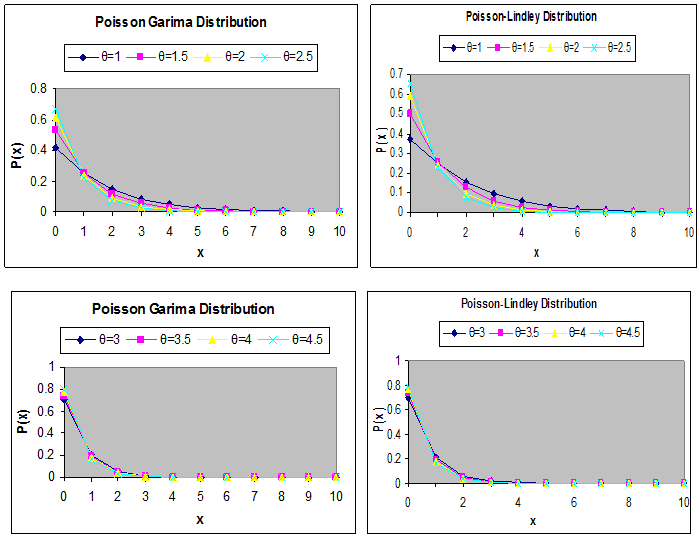
Research Article Volume 5 Issue 2
The discrete poisson-garima distribution
Rama Shanker
Regret for the inconvenience: we are taking measures to prevent fraudulent form submissions by extractors and page crawlers. Please type the correct Captcha word to see email ID.

Department of Statistics, Eritrea Institute of Technology, Eritrea
Correspondence: Rama Shanker, Department of Statistics, Eritrea Institute of Technology, Eritrea
Received: December 13, 2016 | Published: February 13, 2017
Citation: Shanker R. The discrete poisson-garima distribution. Biom Biostat Int J. 2017;5(2):48-53. DOI: 10.15406/bbij.2017.05.00127
Download PDF
Abstract
In this paper, a discrete Poisson-Garima distribution has been obtained by compounding Poisson distribution with Garima distribution introduced by Shanker.1 The general expression for the r th factorial moment has been derived and hence moments about origin and central moments have been obtained. The expression for coefficient of Variation, skewness, kurtosis and index of dispersion has been given. Maximum likelihood estimation and the method of moments have been discussed for estimating the parameter of the distribution. Two examples of real data set have been given to test the goodness of fit of the discrete Poisson-Garima distribution and the fit has been compared with Poisson and Poisson-Lindley distributions.
Keywords: garima distribution, poisson-lindley distribution, compounding, moments, skewness, kurtosis, index of dispersion, estimation of parameter, goodness of fit.
Introduction
Shanker1 introduced a lifetime distribution named Garima distribution having probability density function
(1.1)
to model behavioral science data. It has been shown by Shanker1 that Garima distribution gives much better fit than exponential and Lindley2 distributions and the new lifetime distributions introduced by Shanker3–6 namely Shanker, Akash, Aradhana and Sujatha distributions. The first four moments about origin of Garima distribution obtained by Shanker1 are given by
,
,
.
The central moments of Garima distribution obtained by Shanker1 are as follows
Shanker1 has studied various properties of Garima distribution including its shape, moments, skewness, kurtosis, hazard rate function, mean residual life function, stochastic ordering, mean deviations, order statistics, Bonferroni and Lorenz curves, entropy measure and stress-strength reliability, amongst others. The estimation of the parameter of Garima distribution has been discussed by Shanker1 using both maximum likelihood estimation and the method of moments.
In this paper, a Poisson mixture of Garima distribution named, Poisson-Garima distribution (PGD) has been proposed and its various statistical and mathematical properties have been investigated. The estimation of its parameter has been studied using maximum likelihood estimation and method of moments. Since Poisson-Lindley distribution (PLD), a Poisson mixture of Lindley2 distribution and introduced by Sankaran,7 gives better fit than Poisson distribution, the Poisson-Garima distribution is expected to gives better fit than both Poisson and Poisson – Lindley distribution due to the fact that Garima distribution gives better fit than Lindley distribution. The goodness of fit of the Poisson-Garima distribution has been discussed and it has been compared with that of Poisson and Poisson-Lindley distributions.
Poisson-garima distribution
Assuming that the parameter
of Poisson distribution follows Garima distribution (1.1), the Poisson mixture of Garima distribution can be obtained as
(2.1)
(2.2)
This probability mass function (p.m.f.) has been named as “Poisson-Garima distribution (PGD)”.
It should be noted that Sankaran7 obtained Poisson-Lindley distribution (PLD) having probability mass function (p.m.f)
(2.3)
by compounding Poisson distribution with Lindley distribution, introduced by Lindley2 having probability density function (p.d.f)
(2.4)
The graphs of the pmf of Poisson-Garima distribution (PGD) and Poisson-Lindley distribution (PLD) for varying values of the parameter are shown in the figure 1

Figure 1 Graphs of the pmf of PGD and PLD For Varying Values of the Parameter.
Moments and related measures of PGD
The r th factorial moment about origin of Poisson-Garima distribution (2.2) can be obtained as
, where
Taking
in place of
within bracket, we get
The expression within the bracket is clearly unity and hence we have
Using gamma integral and some algebraic simplification, we get finally a general expression for the r th factorial moment of PGD (2.2) as
(3.1)
Substituting
in (3.1), the first four factorial moments can be obtained and using the relationship between factorial moments and moments about origin, the first four moments about origin of the PGD (2.2) are obtained as
Using the relationship between moments about mean and the moments about origin, the moments about mean of the PGD (2.2) are obtained as
The coefficient of variation
, coefficient of Skewness
, coefficient of Kurtosis
and index of dispersion
of the PGD (2.2) are thus obtained as
To study the nature and behavior of
of PGD and PLD, values of these characteristics for varying values of parameter
have been computed and presented in table 1
|
Values of
for Poisson-Garima Distribution |
1 |
2 |
3 |
4 |
5 |
6 |
|
1.333333 |
0.625 |
0.4 |
0.291667 |
0.228571 |
0.1875 |
|
2.888889 |
0.984375 |
0.551111 |
0.373264 |
0.279184 |
0.221788 |
CV |
1.274755 |
1.587451 |
1.855921 |
2.094697 |
2.311655 |
2.511701 |
|
1.915904 |
2.147798 |
2.355147 |
2.54717 |
2.727407 |
2.897852 |
|
8.210059 |
9.335601 |
10.36498 |
11.36106 |
12.34549 |
13.32641 |
|
2.166667 |
1.575 |
1.377778 |
1.279762 |
1.221429 |
1.18287 |
|
Values of
for Poisson-Lindley Distribution |
|
1 |
2 |
3 |
4 |
5 |
6 |
|
1.5 |
0.666667 |
0.416667 |
0.3 |
0.233333 |
0.190476 |
|
3.25 |
1.055556 |
0.576389 |
0.385 |
0.285556 |
0.225624 |
CV |
1.20185 |
1.541104 |
1.822087 |
2.068279 |
2.290174 |
2.493742 |
|
1.792108 |
2.083265 |
2.314307 |
2.517935 |
2.704839 |
2.87957 |
|
7.532544 |
8.941828 |
10.10611 |
11.17187 |
12.19654 |
13.203 |
|
2.166667 |
1.583333 |
1.383333 |
1.283333 |
1.22381 |
1.184524 |
Table 1 Values of
of PGD and PLD for varying values of the parameter
No. of insects |
Observed Frequency |
Expected Frequency |
PD |
PLD |
PGD |
0
1
2
3
4 |
35
11
8
4
2 |
27.4
21.5
|
33.0
15.3
|
33.3
15.1
6.6
|
Total |
60 |
60.0 |
60.0 |
60.0 |
ML estimate |
|
|
|
|
|
|
7.98 |
2.20 |
1.71 |
d.f. |
|
1 |
1 |
2 |
p-value |
|
0.0047 |
0.1380 |
0.4253 |
Table 2 Distribution of mistakes in copying groups of random digits
No. of errors per Group |
Observed Frequency |
Expected Frequency |
PD |
PLD |
PGD |
0
1
2
3
4
5 |
33
12
6
3
1
1 |
26.4
19.8
|
31.5
14.2
|
31.7
14.0
|
Total |
56 |
56.0 |
56.0 |
56.0 |
ML estimate |
|
|
|
|
|
|
4.87 |
0.53 |
0.38 |
d.f. |
|
1 |
1 |
1 |
p-value |
|
0.0273 |
0.4660 |
0.5376 |
Table 3 Distribution of Pyrausta nublilalis
The graph of the coefficient of variation (C.V), coefficient of skewness
, coefficient of kurtosis
, and index of dispersion
of PGD and PLD are presented in figure 2.

Figure 2 Graphs of (C.V),
,
, and
of PGD and PLD for Varying Values of the Parameter
.
Statistical properties of PGD
The PGD (1.3) is always over dispersed
.
We have
This shows that PGD (2.2) is always over dispersed.
Unimodality and increasing hazard rate
Since
is decreasing function in x,
is log-concave. Therefore, the PGD has an increasing hazard rate and thus unimodal. Detailed discussion about relationship between log-concavity, unimodality and increasing hazard rate of discrete distribution can be seen in Grandell.8
Generating functions
Probability generating function: The probability generating function of the PGD (2.2) can be obtained as
Moment generating function: The moment generating function of the PGD (2.2) is thus given by
.
Estimation of parameter
Maximum likelihood estimate (MLE): Let
be a random sample of size n from the PGD (2.2) and let
be the observed frequency in the sample corresponding to
such that
, where k is the largest observed value having non-zero frequency. The likelihood function L of the PGD (2.2) is given by
The log likelihood function is obtained as
The first derivative of the log likelihood function is given by
where
is the sample mean.
The maximum likelihood estimate (MLE),
of
is the solution of the equation
and is given by the solution of the non-linear equation
This non-linear equation can be solved by any numerical iteration methods such as Newton- Raphson, Bisection method, Regula –Falsi method etc
Method of moment estimate (MOME): Let
be a random sample of size
from the PGD (2.2). Equating the first population moment about origin to the corresponding sample moment, the MOME
of
is given by
where
is the sample mean.
Applications
The PGD has been fitted to a number of data - sets to test its goodness of fit over Poisson distribution (PD) and Poisson-Lindley distribution (PLD. The parameter has been estimated using maximum likelihood estimation. Two examples of observed data-sets, for which the PD, PLD and PGD has been fitted, are presented. The first data-set is due to Kemp and kemp9 regarding the distribution of mistakes in copying groups of random digits and the second data-set is due to Beall10 regarding the distribution of Pyrausta nublilalis.
Conclusions
A discrete Poisson-Garima distribution has been proposed by compounding Poisson distribution with Garima distribution introduced by Shanker.1 Expression for r th factorial moment about origin has been derived and hence moments about origin and central moments have been given. The nature and behavior of coefficient of Variation, skewness, kurtosis and index of dispersion of the proposed distribution have been studied for varying values of the parameter. The estimation of parameter has been discussed using both maximum likelihood estimation and method of moments. The goodness of fit of the proposed distribution has been discussed with two examples of real data set and fit has been compared with Poisson and Poisson-Lindley distributions. The goodness of fit of the Poisson – Garima distribution shows that it gives better fit than both Poisson and Poisson-Lindley distribution and hence it can be considered as an important distribution to model discrete data over these two discrete distributions.
Acknowledgments
Conflicts of interest
References

©2017 Shanker. This is an open access article distributed under the terms of the,
which
permits unrestricted use, distribution, and build upon your work non-commercially.


